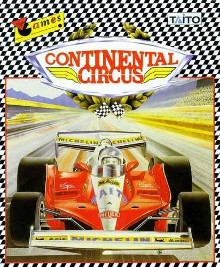
Chase H.Q. is a vehicular combat racing game, originally released as an arcade video game by Taito in 1988. It is sometimes seen as a spiritual successor to Taito's earlier Full Throttle. The player assumes the role of a police officer named Tony Gibson, member of the "Chase Special Investigation Department". Along with his partner, Raymond Broady, he must stop fleeing criminals in high-speed pursuits in a black Porsche 928.

Super Sprint is a racing video game released by Atari Games and Midway Games in 1986. Up to three players drive Formula One-like cars on a circuit that is viewed from above. The game is a successor to Gran Trak 10 and the Sprint series, which were black-and-white games from the 1970s. A sequel, Championship Sprint, was released later in the same year.

Operation Wolf is a light gun shooter arcade game developed by Taito and released in 1987. It was ported to many home systems.

Operation Thunderbolt is a light gun shooter video game developed by Taito and released for arcades in 1988. As the sequel to Operation Wolf, changes include two-player gameplay with two positional gun controllers mounted on the arcade cabinet, and a new forward-scrolling pseudo-3D perspective combined with side-scrolling sections.
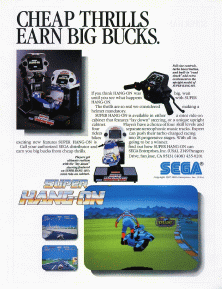
Super Hang-On is a motorcycle racing arcade video game released by Sega as the sequel to Hang-On. It uses a simulated motorcycle arcade cabinet, like the original game. An updated version was released in arcades 1991 as Limited Edition Hang-On.
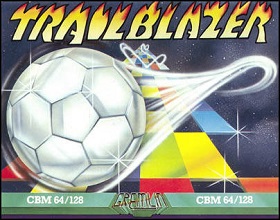
Trailblazer is a racing video game developed by Mr. Chip Software and published by Gremlin Graphics for the ZX Spectrum, Commodore 64, Atari 8-bit computers, Amstrad CPC, Commodore 16 and Plus/4 in 1986. It was ported to the Amiga and Atari ST.

Hot Rod is a top-down arcade racing game developed by Sega. Released for arcades in 1988 in Japan and released worldwide in 1989, the game was available in a four-player cocktail-style arcade cabinet, as well as a three-player upright cabinet. Home computer ports were published by Activision in 1990 for the Amiga, ZX Spectrum, Amstrad CPC, Commodore 64, and Atari ST.

Special Criminal Investigation, also known as S.C.I. for short or as Chase HQ II: Special Criminal Investigation in some home versions, is vehicular combat racing game published by Taito for arcades in 1989. It is the sequel to the 1988 game Chase H.Q.
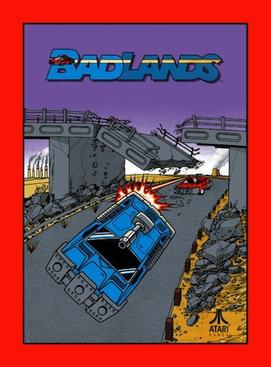
Badlands is a 1989 arcade video game published by Atari Games. It was ported by Domark under the Tengen label to the Amiga, Amstrad CPC, Atari ST, Commodore 64, and ZX Spectrum. The game is a re-themed version of Atari's previous racing games Super Sprint and Championship Sprint with the addition of vehicular combat. Badlands is set in the aftermath of a nuclear war and races around abandoned wastelands with many hazards. Three gun-equipped cars race around a track to win prizes.
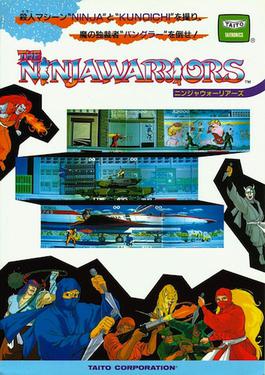
The Ninja Warriors (ニンジャウォーリアーズ) is a side-scrolling beat 'em up video game developed and released by Taito in 1987. The original arcade game situated one display in between projected images of two other displays, creating the appearance of a triple-wide screen. Ports were released for home systems including the Amiga, Atari ST, ZX Spectrum, Commodore 64, Amstrad CPC, PC Engine, and Sega Mega-CD.

Power Drift is a kart racing game released in arcades by Sega in 1988. More technologically advanced than Sega's earlier 2.5D racing games, like Hang-On (1985) and Out Run (1986), in Power Drift the entire world and track consist of sprites. The upgraded hardware of the Sega Y Board allows individual sprites and the background to be rotated–even while being scaled–making the visuals more dynamic.

Silkworm is a horizontally scrolling shooter developed by Tecmo and first released for arcades in 1988. In 1989 it was ported to the Amiga, Atari ST, Commodore 64, ZX Spectrum, Amstrad CPC and NES (1990) systems by The Sales Curve and released by Virgin Mastertronic.

Enduro Racer (エンデューロレーサー) is an arcade racing game from Sega. It was released in 1986 with two arcade cabinet versions, a stand-up cabinet with handlebars and a full-sized dirt bike cabinet. It is often seen as a dirt racing version of Hang-On, as it uses a similar engine and PCB. The game was later released for the Master System in 1987, the ZX Spectrum and Commodore 64 in 1988, and the Amstrad CPC and Atari ST in 1989.

Thunder Blade is a third-person shoot 'em up video game released by Sega for arcades in 1987. Players control a helicopter to destroy enemy vehicles. The game was released as a standard stand-up arcade cabinet with force feedback, as the joystick vibrates. A helicopter shaped sit-down model was released, replacing the force feedback with a cockpit seat that moves in tandem with the joystick. It is a motion simulator cabinet, like the previous Sega Super Scaler games Space Harrier (1985) and After Burner (1987). The game's plot and setting was inspired by the film Blue Thunder (1983).

WEC Le Mans, known as WEC Le Mans 24 in Japan, is a racing simulation video game released in arcades by Konami in 1986. It was the first racing video game to depict the 24 Hours of Le Mans World Endurance Championship (WEC). The Lap of Le Mans is split up into three sections, during which the time of day changes from day to dusk, dusk to night, and night to dawn.
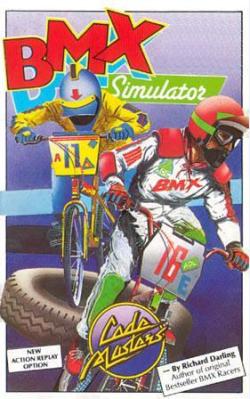
BMX Simulator is a racing video game designed by Richard Darling and released by Codemasters in 1986 for the Commodore 64. It is part of a series of games that includes ATV Simulator, Grand Prix Simulator, Professional Ski Simulator, and a sequel: Professional BMX Simulator. BMX Simulator was ported to the Amiga, Atari 8-bit computers, Atari ST, Amstrad CPC, MSX, ZX Spectrum, Commodore Plus/4 and Commodore 16.

Grand Prix Simulator is a racing game developed by The Oliver Twins and published by Codemasters for the ZX Spectrum, Amstrad CPC, Commodore 64, and Atari 8-bit computers. The ZX Spectrum conversion was done by Serge Dosang. The game was endorsed by Ayrton Senna's 1986 Formula One teammate Johnny Dumfries.
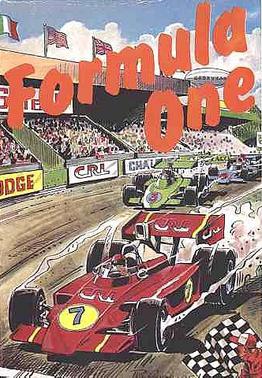
Formula One is a Formula One racing management video game published in 1985 by CRL Group PLC. It was developed by G.B. Munday and B.P. Wheelhouse for the ZX Spectrum, and converted to Amstrad CPC by Richard Taylor.

Ghostbusters II is a 1989 action game based on the film of the same name. It was published by Activision for various computer platforms. British studio Foursfield developed a version for Commodore 64, Amiga, Atari ST, Amstrad CPC and ZX Spectrum, which also got ported to the MSX by New Frontier. It features three levels based on scenes from the film. Dynamix developed a separate version for the DOS, also based on the film. The non-DOS versions were praised for the graphics and audio, but criticized for long loading times, disk swapping, and the final level. The DOS, Commodore 64 and Amiga versions were the only versions released in North America.
